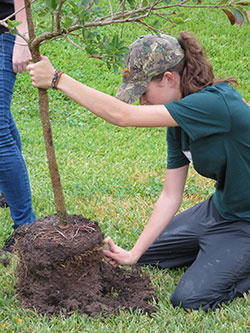Today@Sam Article
SHSU Recognized As 'Tree Campus USA'
March 20, 2015
SHSU Media Contact: Julia May
 The Arbor Day Foundation has honored Sam Houston State University as a 2014 Tree Campus USA for its commitment to sound urban forest management.
The Arbor Day Foundation has honored Sam Houston State University as a 2014 Tree Campus USA for its commitment to sound urban forest management.
The announcement comes as SHSU is preparing for Sam Houston Arbor Day, which will take place March 26 with activities beginning at 2 p.m. for students, faculty, and staff.
In addition to planting trees on campus, individuals will be able to participate in educational activities to increase their knowledge about trees and the significance of Arbor Day. Registration for participation must be done by noon on Wednesday (March 25). Additional information and the registration form are available at shsu.edu/~org_cls/ArborDay.html.
Tree Campus USA is a national program created in 2008 to honor colleges and universities for effective campus forest management and for engaging staff and students in conservation goals.
“Being awarded the designation of Tree Campus USA, and so soon after initiating a Campus Tree Program, is a huge honor for the university,” said Scott Dolezal, manager of SHSU Grounds and Custodial Services. “The designation shows the university’s sense of responsibility to the environment and commitment to quality programs that enhance the lives of the campus and local community.”
SHSU achieved the Tree Campus USA title by meeting the program’s five core standards: creating a tree advisory committee, writing a campus tree-care plan, dedicated annual expenditures for the campus tree care program, observing Arbor Day, and having a student service-learning project to engage the student body.
“Scott had been working on a campus tree plan, and when I was employed last year, I began working toward the goal of getting the university designated as Campus Tree USA,” said Evan Anderson, SHSU arborist.
With an undergraduate degree in forestry and a master’s degree in tropical environmental management, Anderson brings his experiences from working with the Peace Corps, Texas Forest Service and environmental organizations in Texas, California and Australia to the university.
The first thing he did at SHSU was write a campus tree care plan to define the policies and guidelines for establishing and maintaining a “safe, sustainable, healthy and attractive campus urban forest.”
The plan covers new tree selection, planting trees, pruning objectives, pruning techniques, tree removal, pest and disease management, tree protection, and storm recovery.
“When you first start a tree care program, safety is the number one thing that you have to be mindful of,” he said. “We have to find the problem trees before they fall apart and damage property or injure people.”
Even now, the campus is still dealing with the effects of the 2011 drought.
“A drought often causes a delayed reaction in the demise of a tree,” Anderson said. “The tree may appear to have survived, when, in fact, its system has been compromised to the point that it can’t fight off insects and diseases, or it can no long produce enough energy to survive.
“At first, it looks like we are just going around, removing trees to be removing trees,” he said. “However, we are taking the unhealthy ones down before they pose a risk to people or the rest of the trees on campus.”
An SHSU tree advisory committee is also in place now. Its members include Dolezal; Anderson; Sharon Frey, SHSU horticulture lecturer; Josh Mizrany, Texas A&M Forest Service resource specialist; Jordan Herrin, Texas A&M Forest Service district forester; and SHSU undergraduate students Kaleigh Treiber and Khelsea Herrick.
The committee analyzes current topics that impact trees on campus, discusses new and existing management techniques, and serves as an open forum for learning.
Anderson’s next goal is to conduct a university-wide tree inventory.
“There have been partial inventories in the past, but I’d like to use a software program that gives us more information about every tree on campus—not just what kind it is or its size, but also tells us what the environmental benefits are of having that tree, how much shade it provides and how much energy that saves the university, does it prevent runoff, how many pollutants it’s taking out of the air, how much oxygen it’s providing and carbon it’s sequestering, etc.,” he said.
“It’s not just shovels and chainsaws anymore,” he said. “A lot of technology goes into tree care now. We can do a lot of assessment with no harm done to trees.”
In addition to Sam Houston Arbor Day, the campus will participate in Texas Arbor Day activities in November.
“That’s when we do our big tree plantings, because that’s the best time to plant trees in the state of Texas. At that time, we will reforest an area of campus,” he said.
Anderson relies on the SHSU Grounds Crew to help with projects, and he collaborates with Physical Plant for planning.
“In an urban forest, you have to consider things other than the trees. There are buildings, lighting, sidewalks, landscapes, and new construction,” he said. “Each piece is important.”
Anderson strongly supports biodiversity with tree planting and tries to educate the public about its importance.
“Instead of planting 20 trees of one species, we should be planting many different species,” he said. “That way, when we do have insects or diseases showing up, all the trees won’t be wiped out at once. We live in a global society; people and products move around with greater ease. Unfortunately, with these movements, plant and animal diseases are moving around more easily, as well.
“While this is a problem, it’s also one of the things that make being an arborist exciting,” he said. “We must constantly be watching and learning new things.”
- END -
This page maintained by SHSU's Communications Office:
Director of Content Communications: Emily Binetti
Asst. Director Content & Social Media: Emilee White
Communications Manager: Mikah Boyd
Telephone: 936.294.1837
Communications Specialist: Campbell Atkins
Telephone: 936.294.2638
